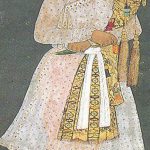
Art History/Craft History, Craft, Handloom, Art
The Work of Fairies: The Muslin Jamdani of India
Sethi, Ritu
October, 2018
It wasn’t just the Romans who described it as woven winds in the 1stc, in the 7th c the Chinese monk andcerebraltraveller Hsüan-tsang described it as “…the light vapors of dawn”. Many centuries on in the 13thc AmīrKhusrow the great Sufi musician, poet and scholar described it as the ‘…skin of the moon.’Themost exceptional pieces were reserved for the Mughal Emperors. With the testing of its airy weightlessness was by drawing it through a finger-ring it drew censure from the austere Emperor Aurangzeb (1618–1707) who is reputed to have reprimanded his daughterPrincess Zebunissafor appearing inadequately dressed when she was actuallydraped in 7 layers of the finest.Jean-Baptiste Tavernier the 17th c traveller too commented on its sheerness, stating “that when a man puts it on, his skin shall appear through it, as if he were naked.’
In Europe it was worn by the doomed Empress Marie Antoinette (1755 – 93), and the Empress Josephine who followed. The British too could not have enough of it and in the 19th c it was described by Edward Baines, Member of parliament as it‘…might be thought the work of fairies, or of insects, rather than of men’. In 1811 the author Jane Austen wrote to her sister on how she succumbed to its charms ‘… I am getting very extravagant and spending all my money and…I have been spending yours too in a linen-draper’s shop which I went to for check’d muslin, and for you …I was tempted by a ...
PRACTITIONERS: INDIA
Access 70,000+ practitioners in 2500+ crafts across India.
BIBLIOGRAPHY
10,000+ listings on arts, crafts, design, heritage, culture etc.
GLOSSARY
Rich and often unfamiliar vocabulary of crafts and textiles.
SHOP at India InCH
Needs to be written.






